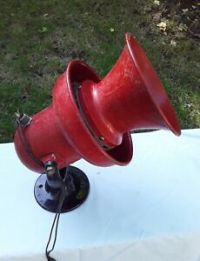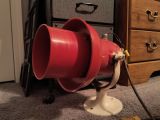Model D
| Federal Signal Model D | |
 A privately owned Federal Sign & Signal Model D. | |
| Company | Federal Signal Corporation |
|---|---|
| Produced | 1943?-Early 1980s |
| Type | Directional Electromechanical |
| Sound output | 112 dB @ 10 feet |
| Horsepower | 1/2 hp |
| Voltage | 12/24/120/240 V AC/DC |
| Preceded by | Federal Signal Model A |
| Succeeded by | Federal Signal Model L |
The Model D was a small electric industrial siren that was produced by the Federal Signal Corporation. The siren was intended for indoor industrial use, as well as short range outdoor use. The Model D shared this purpose with the Model A and Model L in Federal Signal's lineup, ultimately being discontinued due to being overall redundant.
History and design

The Model D was introduced sometime before 1943, with the first known concrete advertisement of the siren dating to that year. The Model D and Model L are nearly identical sirens (as the Model L is a heavy-duty variant of the Model D), sharing almost the exact same rotor, stator, motor, and motor housing/stand. The only notable difference between a Model L core and a Model D core is the number of finger guards used. Model Ls have two guards per stator port, while the Model D only has one. The Model D uses a flared intake similar to the Model A, while the Model L uses a larger cylindrical intake.
The Model D uses a small 8-port aluminum rotor and stator, driven by a 1/2 hp AC/DC universal motor running at either 12 V DC or 120/240 V AC. The motor runs at a high RPM, with the siren peaking at a relatively high pitch. Due to the siren's small size, finger guards are included on the stator ports. The Model D is rated at 112 dB at 10 ft, with an operating range of 200 ft. Like many of Federal's small sirens, the Model D was compatible with the Pulsator attachment, with units having factory installed Pulsators being designated as the Model PD.
Like most small industrial sirens, the siren is simple in design. By default, the Model D comes with a metal stand which attaches to the rounded motor cover through two swivel mounts, which allows the siren to be aimed vertically wherever is required. These mounts are secured by nuts to keep them in place. The stand includes holes for mounting on a wall, floor or ceiling. The siren uses a flanged outer skirt to project the sound, and originally used a flared intake similar to the Model A, possibly intended to increase sound pressure to the rotor. Late into the siren's production run in the 1970s, the Model D was redesigned to use the same cylindrical intake as the Model L, effectively turning the siren into an identical clone of the Model L. The Model D's rotor and stator set found much use by Federal Signal for their other sirens, including various vehicular sirens, its successor the Model L, and the Model 1/2.

A lower-pitched variant of the Model D was available through special order, though it was not given a different name. This variant used a 5-port rotor and stator instead of the standard 8, which gave it a much deeper tone similar to a Model 2. This may have been more desirable for Model Ds used outdoors, as the lower pitch would carry further than a standard model. This option was seldom bought by customers, and these lower pitched units are uncommon to find today. These are often mistakenly called the "Model A-5" despite the tags simply stating "Model D".
The Model D was not as successful as the Model A, selling far fewer units. By the end of the siren's production run, the siren was simply a redundant clone of the Model L, leading to Federal Signal discontinuing the siren in the early 1980s. Other sirens such as the Model J were discontinued as well, simplifying Federal's lineup to only include the Model A and Model L. Today, Model Ds are a somewhat rare find, as most places opted to go for the Model A, L, or the Sterling/Sentry F-2. They are a popular siren for enthusiasts, due to their small size and ease of operation.